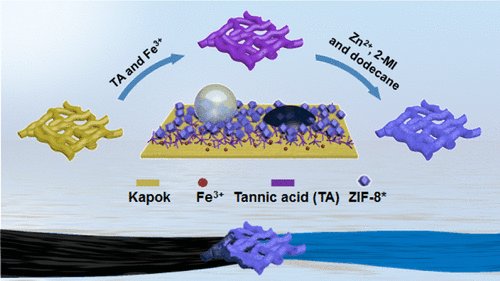当前位置:
X-MOL 学术
›
ACS Sustain. Chem. Eng.
›
论文详情
Our official English website, www.x-mol.net, welcomes your feedback! (Note: you will need to create a separate account there.)
Superhydrophobic Metal–Organic Framework Nanocoating Induced by Metal-Phenolic Networks for Oily Water Treatment
ACS Sustainable Chemistry & Engineering ( IF 8.4 ) Pub Date : 2020-01-22 , DOI: 10.1021/acssuschemeng.9b05937 Weiran Li 1 , Jiafu Shi 1, 2, 3, 4 , Yang Zhao 1 , Qian Huo 3, 5 , Yiying Sun 3, 5 , Yizhou Wu 3, 5 , Yu Tian 1 , Zhongyi Jiang 2, 3, 4, 5
ACS Sustainable Chemistry & Engineering ( IF 8.4 ) Pub Date : 2020-01-22 , DOI: 10.1021/acssuschemeng.9b05937 Weiran Li 1 , Jiafu Shi 1, 2, 3, 4 , Yang Zhao 1 , Qian Huo 3, 5 , Yiying Sun 3, 5 , Yizhou Wu 3, 5 , Yu Tian 1 , Zhongyi Jiang 2, 3, 4, 5
Affiliation

|
Metal–organic frameworks (MOFs) with tailored chemical compositions and topological structures have exhibited good application potential in the fields of adsorption, catalysis, and so on. In our study, an aerogel that is composed of a kapok fiber core and MOF nanocoating was fabricated through growing hydrophobic ZIF-8 on the kapok surface induced by Fe3+-tannic acid networks (FTN). Briefly, kapok, a typical fiber in nature, was first pretreated by NaClO2 solution and then coated by FTN through coordination-enabled assembly/adhesion of Fe3+ and tannic acid. Then, the growth of ZIF-8 nanocoating was triggered by FTN, where the dodecane was in situ anchored on the as-formed ZIF-8, thus forming the ZIF-8*/FTN/kapok aerogel. The resultant aerogel exhibited a lotus leaf-like surface, where ZIF-8 and dodecane, respectively, mimicked the nubs and the wax on the lotus leaf. As a result, the aerogel showed a superhydrophobic surface that exhibited a water contact angle of 162.31°, which could absorb a series of oils/organics with the capacities of 20.0–72.0 g g(sorbent)–1, over 17–40 times higher than ZIF-8* particles depending on the types of oils/organics. Moreover, the aerogel showed superior recyclability, which retained over 75.64% of its original sorption capacity after 50 cycles. By using of our method, the hydrophobic MOF nanocoating could be grown on a broad range of materials, which would broaden the application of MOFs.
中文翻译:

金属-酚醛网络诱导的超疏水金属-有机骨架纳米涂层处理含油水
具有特定化学成分和拓扑结构的金属有机骨架(MOF)在吸附,催化等领域具有良好的应用潜力。在我们的研究中,由木棉纤维芯和MOF纳米涂层组成的气凝胶是通过在Fe 3+-鞣酸网络(FTN)诱导的木棉表面上生长疏水性ZIF-8制成的。简而言之,首先使用NaClO 2溶液对木棉(一种自然界中的典型纤维)进行预处理,然后通过能够配位组装/粘合Fe 3+进行FTN涂覆和单宁酸。然后,FTN触发ZIF-8纳米涂层的生长,其中十二烷原位固定在形成的ZIF-8上,从而形成ZIF-8 * / FTN / kapok气凝胶。所得的气凝胶表现出荷叶状的表面,其中ZIF-8和十二烷分别模仿荷叶上的小块和蜡。结果,气凝胶显示出超疏水性表面,其水接触角为162.31°,可以吸收一系列油/有机物,容量为20.0–72.0 gg (吸附剂)–1取决于油/有机物的类型,比ZIF-8 *颗粒高出17–40倍。此外,气凝胶显示出优异的可回收性,在50个循环后,其保留了其原始吸附能力的75.64%以上。通过使用我们的方法,疏水MOF纳米涂层可以在多种材料上生长,这将拓宽MOF的应用范围。
更新日期:2020-01-23
中文翻译:

金属-酚醛网络诱导的超疏水金属-有机骨架纳米涂层处理含油水
具有特定化学成分和拓扑结构的金属有机骨架(MOF)在吸附,催化等领域具有良好的应用潜力。在我们的研究中,由木棉纤维芯和MOF纳米涂层组成的气凝胶是通过在Fe 3+-鞣酸网络(FTN)诱导的木棉表面上生长疏水性ZIF-8制成的。简而言之,首先使用NaClO 2溶液对木棉(一种自然界中的典型纤维)进行预处理,然后通过能够配位组装/粘合Fe 3+进行FTN涂覆和单宁酸。然后,FTN触发ZIF-8纳米涂层的生长,其中十二烷原位固定在形成的ZIF-8上,从而形成ZIF-8 * / FTN / kapok气凝胶。所得的气凝胶表现出荷叶状的表面,其中ZIF-8和十二烷分别模仿荷叶上的小块和蜡。结果,气凝胶显示出超疏水性表面,其水接触角为162.31°,可以吸收一系列油/有机物,容量为20.0–72.0 gg (吸附剂)–1取决于油/有机物的类型,比ZIF-8 *颗粒高出17–40倍。此外,气凝胶显示出优异的可回收性,在50个循环后,其保留了其原始吸附能力的75.64%以上。通过使用我们的方法,疏水MOF纳米涂层可以在多种材料上生长,这将拓宽MOF的应用范围。


























 京公网安备 11010802027423号
京公网安备 11010802027423号